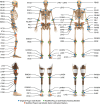A kinematic and kinetic dataset of 18 above-knee amputees walking at various speeds
- PMID: 32439980
- PMCID: PMC7242470
- DOI: 10.1038/s41597-020-0494-7
A kinematic and kinetic dataset of 18 above-knee amputees walking at various speeds
Abstract
Motion capture is necessary to quantify gait deviations in individuals with lower-limb amputations. However, access to the patient population and the necessary equipment is limited. Here we present the first open biomechanics dataset for 18 individuals with unilateral above-knee amputations walking at different speeds. Based on their ability to comfortably walk at 0.8 m/s, subjects were divided into two groups, namely K2 and K3. The K2 group walked at [0.4, 0.5, 0.6, 0.7, 0.8] m/s; the K3 group walked at [0.6, 0.8, 1.0, 1.2, 1.4] m/s. Full-body biomechanics was collected using a 10-camera motion capture system and a fully instrumented treadmill. The presented open dataset will enable (i) clinicians to understand the biomechanical demand required to walk with a knee and ankle prosthesis at various speeds, (ii) researchers in biomechanics to gain new insights into the gait deviations of individuals with above-knee amputations, and (iii) engineers to improve prosthesis design and function.
Conflict of interest statement
The authors declare no competing interests.
Figures


References
-
- Whittle MW. Clinical gait analysis: A review. Hum. Mov. Sci. 1996;15:369–387. doi: 10.1016/0167-9457(96)00006-1. - DOI
-
- Davis, R. B., Ounpuu, S., DeLuca, P. A. & Romness, M. J. Clinical Gait Analysis and Its Role in Treatment Decision-Making. Medscape Gen. Med. 1–21 (2002).
Publication types
MeSH terms
Grants and funding
- W81XWH-16-1-0701/U.S. Department of Defense (United States Department of Defense)/International
- W81XWH-16-1-0701/U.S. Department of Defense (United States Department of Defense)/International
- W81XWH-16-1-0701/U.S. Department of Defense (United States Department of Defense)/International
- W81XWH-16-1-0701/U.S. Department of Defense (United States Department of Defense)/International
LinkOut - more resources
Full Text Sources
Medical

